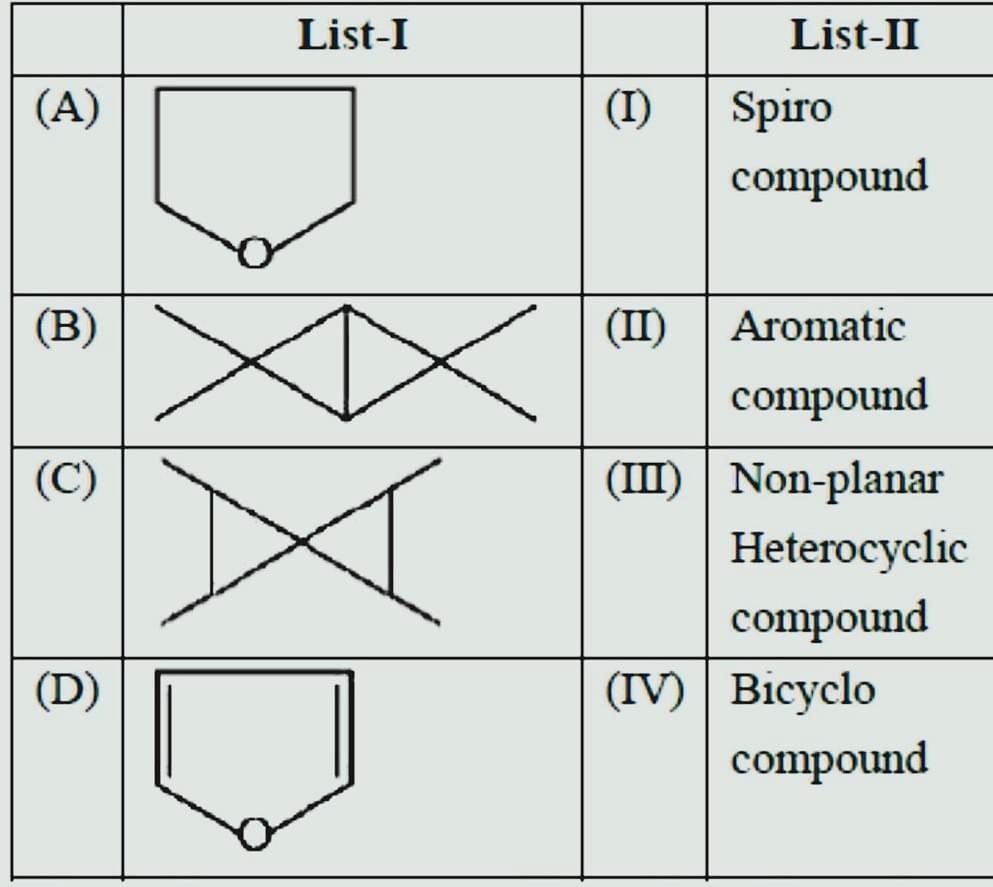Match List-I with List-II


- (A) - (I), (B) - (I), (C) - (IV), (D) - (III)
- (A) - (II), (B) - (I), (C) - (IV), (D) - (III)
- (A) - (III), (B) - (IV), (C) - (I), (D) - (II)
- (A) - (IV), (B) - (III), (C) - (II), (D) - (I)
The Correct Option is C
Solution and Explanation
The correct option is (C): (A) - (III), (B) - (IV), (C) - (I), (D) - (II)
Top Questions on Aromatic Hydrocarbon
Which of the following are aromatic?

- CUET (PG) - 2025
- Chemistry
- Aromatic Hydrocarbon
- When C6H5CHO reacts with the mixture of HNO3 and H2SO4 at 273-283K, it gives
- KEAM - 2025
- Chemistry
- Aromatic Hydrocarbon
- The temperature and pressure required for reforming benzene from n-hexane is
- KEAM - 2025
- Chemistry
- Aromatic Hydrocarbon
- Which of the following is non-aromatic?
- KEAM - 2025
- Chemistry
- Aromatic Hydrocarbon
Give plausible explanation for:
(a) Diazonium salts of aromatic amines are stable.
(b) Aniline does not undergo Friedel-Crafts reaction.
(c) Aniline on nitration gives substantial meta product.- CBSE CLASS XII - 2024
- Chemistry
- Aromatic Hydrocarbon
Questions Asked in JEE Main exam
- The value of \( (\sin 70^\circ)(\cot 10^\circ \cot 70^\circ - 1) \) is:
- JEE Main - 2025
- Trigonometric Identities
- 10 mL of 2 M NaOH solution is added to 20 mL of 1 M HCl solution kept in a beaker. Now, 10 mL of this mixture is poured into a volumetric flask of 100 mL containing 2 moles of HCl and made the volume upto the mark with distilled water. The solution in this flask is :
- JEE Main - 2025
- Solutions
Consider the following sequence of reactions :

Molar mass of the product formed (A) is ______ g mol\(^{-1}\).- JEE Main - 2025
- Organic Chemistry
- A group 15 element forms \( d\pi - d\pi \) bond with transition metals. It also forms a hydride, which is the strongest base among the hydrides of other group members that form \( d\pi - d\pi \) bonds. The atomic number of the element is ________________________.
- JEE Main - 2025
- Chemical bonding and molecular structure
- Let \( M \) denote the set of all real matrices of order 3 x 3 and let \( S = \{-3, -2, -1, 1, 2\} \). Let
\( S_1 = \{A = [a_{ij}] \in M : A = A^T \text{ and } a_{ij} \in S, \forall i, j\} \),
\( S_2 = \{A = [a_{ij}] \in M : A = -A^T \text{ and } a_{ij} \in S, \forall i, j\} \),
\( S_3 = \{A = [a_{ij}] \in M : a_{11} + a_{22} + a_{33} = 0 \text{ and } a_{ij} \in S, \forall i, j\} \).
If \(n(S_1 \cup S_2 \cup S_3) = 125\), then \( \alpha \) equals:- JEE Main - 2025
- Linear Algebra
Concepts Used:
Aromatic hydrocarbon
Aromatic hydrocarbons, sometimes known as arenes, are aromatic organic molecules made up entirely of carbon and hydrogen. In aromatic compounds a benzene ring which is named after the simple aromatic chemical benzene, or a phenyl group when part of a larger structure, is the configuration of six carbon atoms.
Read More: Aromaticity
Reactions of Aromatic Hydrocarbons:
1. Aromatic Substitution Reactions
This reaction involves the replacement of one substituent on the ring of an aromatic hydrocarbon, commonly a hydrogen atom, by a different substituent group.
The common types of aromatic substitution reactions are:
- Nucleophilic aromatic substitution reactions
- Electrophilic aromatic substitution reactions
- Radical nucleophilic aromatic substitution reactions
2. Coupling Reactions
In these types of reactions, the coupling of two fragments that have a radical nature is achieved with the help of a metal catalyst